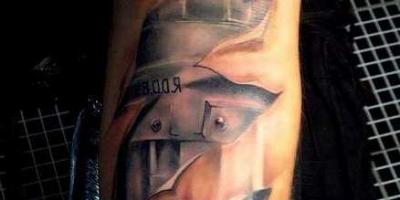My child and I are learning to write block letters using dots. The letters are already written with a dotted line, you need to carefully circle them
Before learning to write capital letters in real copybooks, you need to learn how to “print” them, that is, write them in block letters. There are practically no such “copybooks” anywhere, and it is very necessary to teach a child to write block letters.
Print out these cards, maybe in several copies at once, and let your child practice tracing the letters until he gets neat, even lines.
All letters are written with dots, the baby just needs to trace them with a pencil, thanks to such exercises the baby will remember the letters, and will also learn to write them correctly







Download file: (downloads: 531)
Dear readers!
All materials from the site can be downloaded absolutely free. All files have been scanned by antivirus and do not contain hidden scripts.
Pictures in archives are not marked with watermarks.
The site is updated with materials based on the free work of the authors. If you want to thank them for their work and support our project, you can transfer any amount that is not burdensome to you to the site’s account.
Thank you in advance!!!
Preparing this display took us a lot of time. We have tried to collect here all the recipes for preschoolers known to us that have ever been released on the market. Some of them have not been used in educational institutions for a long time, but this does not make them ineffective in teaching children to write.
With the help of letters and numbers, your child will learn the basics of writing and literacy, and will be able to independently write numbers on paper in a square or line.
In mathematics (numbers)
Mathematical copybooks are an indispensable assistant in preparing for school. Practice shows that children whose parents taught them how to write numbers correctly more often become excellent and good students in elementary school.Kolesnikova E.V. for 5-7 years old math by cells
DownloadKolesnikova E.V. for 4-5 years old math steps

Download link
Shevelev K.V. for 6-7 years old mathematical copybooks

Part 1
Part 2
Pererson L.G. and Suvorina E.A. - learning to write numbers for 3-4 years and older
This book is in two parts from famous authors for free download. In the preparatory group of kindergarten it is often used by teachers. It never hurts to practice with your child.
Part 1
Part 2 The manual will teach your child how to spell numbers, which is so necessary for learning mathematics in the 5th grade. It also contains tasks for the development of graphic skills, and for a mathematical bias - geometric shapes.

Nefedova and Uzorova 3000 exercises for preschoolers
This manual contains not only a sample and example of what this kind of manual should look like, but also a full cycle of teaching how to spell numbers. Perhaps these are the best copybooks..Download for free and without registration
Russian language and literacy (letters)
Russian workbook for 5-6 years old, checkered
This literacy guide is intended for children in the senior group of kindergarten. Funny copybooks for children, in which the main character is a duckling, will help teach future first-graders how to write the elements of letters. The entire alphabet in the form of a copybook is in front of us.
Printed and written letters Fedosov N.A. for 5-7 years
These copybooks will teach any child how to write uppercase and lowercase letters. They comply with the Federal State Educational Standard. Designed for use in preschool educational institutions.
Lunkina - preparation for school 5-7 years literacy training
In these copybooks, the author Lunkina teaches children to read and write in an entertaining way. First sticks and hooks, and then the whole alphabet, then letter combinations. And all this with a workbook with tasks.
Buneev R.N., Buneeva E.V., Pronin O.V. by letter
2 parts of a textbook from famous authors for preparing for school. With their help you can learn how to print block letters. We ourselves learn to write letters with their help.
Download and print part 1
Download and print part 2
Developing letters from Nyankovskaya N.N.
Helps to form a graphic representation of letters and their connection. An interesting and educational guide for preschoolers. Most of the book is devoted to hooks, dashes, shading, ticks, and lines. Only then does learning move on to letters.
First and correct! With shading
This manual contains the whole alphabet. 98 pages to learn how to write all the letters of the Russian alphabet. Everything is depicted quite large. A great idea both for preparing for school and for younger preschoolers.
Denisova, Dorozhkin for preparatory group
Literacy lessons for kids from the domestic publishing house of copybooks.
Zhirenko, Kolodyazhnykh - elements of letters, basic writing
An excellent tool for developing writing skills in preschool children.
Vowels and consonants. Author: Zhukova

We did not post the copybooks of the authors Ilyukhina, Kozlova, Vasilyeva, Belykh and Nishcheva, due to the fact that we have already heard stories about complaints from copyright holders about sites where files for downloading are posted. We hope for your understanding and are constantly working to improve the content of the site.
In an oblique ruler
Copybook pictures (templates)
Letters of the Russian alphabet
The letter a
Today's school places quite serious demands on 6-7 year old children entering first grade. It is no longer possible to count on the fact that, as once in the past, children will come to school and be taught everything there. One of the most important signs of a child’s readiness for school is the development of fine motor skills and initial writing skills.
It is to solve this problem that experts have developed recipes. These simple squiggles, lines, pictures help him get used to the pen, develop his hand, and develop the skill of writing future parts of letters and numbers. To help preschoolers prepare for school, parents, thanks to the Internet, can print out copybooks for children 6-7 years old for free.
But you need to start preparing in advance. The first prescriptions can be given to children as early as three years old. For this purpose, special educational funny pictures and patterns are being developed for children 3-4 years old, by tracing which they begin their first acquaintance with pencils and pens.

To print, click on the picture, it will open in a special window, then right-click on the picture and select “Print”
Coloring books with pictures and the simplest lines and shapes become the first stage of learning for children. The baby gets used to holding a pencil or brush in his hands, coloring his favorite characters. Some coloring pages also include a copybook element, when the silhouette of the drawing is made in the form of a thin dotted line. The young artist traces it to make the drawing bright and clear, learning to draw smooth lines this way.
Copybooks for children 3-4 years old do not include either letters or numbers. Preschoolers learn to trace simple geometric shapes, large drawings and lines. Sticks and hooks are built into the coloring pattern. The child can first color the drawing and then trace these elements.
Adults make sure that the line the baby leads is not interrupted and does not go far beyond the contour.
Even if your children have passed the age of 3-4 years, it is worth checking how easily they work with coloring pages and the simplest copybooks before moving on to the next stage. The more a preschooler draws in coloring books (any kind), the more fine motor skills of his hands develop, the easier it will be for him to write.
Copybooks for children - learning to write in a playful way
Letters and numbers

At the age of 5-6 years, children begin to be introduced to letters and numbers and master their writing. First, they learn to write the elements of letters correctly - hooks and squiggles, sticks and lines. Printed letters are necessarily included in the copybooks for children aged 5-6 years, which they trace along the dotted lines.
When teaching children to write letters, one should not forget about numbers. Learning to write them is no less difficult for kids. At this age, the preschooler also begins by mastering the correct spelling of numbers.
Initially, at the first stage of working with writing letters and numbers, parents hold the baby’s hand in theirs. This way he can feel the correct order of hand movement. This is very important for the subsequent beauty and correctness of writing. After the preschooler understands how to act, he will trace the lines himself.
Alphabet for schoolchildren

At the age of 6-7 years, children come to school and begin to learn the Russian language. The correct order of writing letters determines the speed of writing in the future, the beauty and clarity of handwriting. The teacher at school does not have enough time to work on this. Here parents and copybooks come to the aid of the student. At 6-7 years old, children should already be able to master capital letters. In the copybooks, arrows indicate the direction of hand movement. Parents must ensure that the beginning student follows these instructions.
Copybooks - mathematical

In order for children 6-7 years old to have success in mathematics, parents should use mathematical copybooks. They include examples of writing numbers and their elements, simple examples, and geometric shapes. If a little student practices writing numbers at home until it becomes automatic, without confusing, for example, 6 and 9, this will give him more time in mathematics at school to understand the essence of the examples, problems and rules that the teacher explains.
Copybooks - English language

Often, children aged 6-7 years already begin to learn English. Writing the English alphabet has its own specifics. It includes both letters corresponding to the Russian alphabet and those completely unfamiliar to children before. Even letters similar to Russian are written slightly differently, and completely new ones are especially difficult to master. Here, copybooks with English letters will also come to the aid of students. All these necessary and educational copybooks can be downloaded and printed completely free of charge.
Capital letters for children, learn to write Russian capital letters
The ability to write is one of the most important skills, along with reading, that any person should master (see also:). Many parents unreasonably believe that they need to start teaching their child as early as possible, that this skill is the highest indicator of the level of development. Is it so? Many experts agree that you should not start teaching your child to write until he is 5-6 years old. Teaching a preschooler to write beautifully is not an easy task; it requires composure, perseverance and attentiveness.
All parents want to be proud of their child and try to teach him to write at an early age. But this approach can only do harm if you don’t know how to deal with your child correctly.
Children aged 3-4 years, for the most part, are fidgety. They want to run, jump, play, but not write out some letters and numbers in boring copybooks. If you still decide to teach your child to write, then remember: now you will need to practice penmanship with your child regularly, otherwise after a while he may forget everything you taught him!
Not everyone may like these activities, so he may begin to write letters and numbers quickly and sloppily, wanting to finish with them as quickly as possible and eventually move on to some more interesting things. All this can lead to the development of ugly handwriting, which will not be so easy to correct later. Let's figure out what experts are talking about: is it worth starting to teach children to write in preschool age, how effective will such classes be and their consequences?
Should parents teach a child under 5 to write?
Teaching children to write at 3-4 years old is not worth it for a number of reasons:
- Children lose the sense of novelty inherent in learning at school. When a student realizes that all they start learning in class is writing numbers and letters, he loses all interest in learning. The child becomes bored and lazy to complete the task. We are no longer talking about any incentive and joy to learn new things every day.
- Writing skills turn out to be incorrect. Two experts in the field of child development (physiologist Maryana Bezrukikh and early development specialist Lena Danilova) are convinced that the development of writing skills, including penmanship and speed writing, does not occur in one year, but gradually. This takes years. You shouldn’t throw all your energy into teaching your child to write beautifully. All this may negatively affect his entire style of writing in the future.

 Correct posture must be developed from a very early age, as soon as the baby takes his first pencil and sits down to draw at the table. This will help avoid many spinal problems in the future.
Correct posture must be developed from a very early age, as soon as the baby takes his first pencil and sits down to draw at the table. This will help avoid many spinal problems in the future. At first, a preparatory base will be sufficient for training. Teach your baby to sit at the table in the correct position, and also teach how to grasp a pencil or pen. Over time, you can begin the learning process, but remember that it is important to be consistent in your teaching techniques. Each number and each letter should be explained separately, explaining and comparing. A child is only able to fully evaluate the technique of writing a particular letter when he or she is closer to 5-6 years of age.
Haste in learning always only causes harm; it is especially important not to rush at first. By pushing your child, you will cause him to make mistakes in writing individual elements.
Increasingly, irregularities in height and width and slope will occur. It will become almost impossible for your baby to connect letters into words. Then, upon entering first grade, the child will fall into the hands of a teacher who will be forced to correct many of your mistakes.
When should you start?
Usually, it is at school that we learn to write letters and numbers beautifully. Learning to write there occurs in several stages: first, children are shown how to sit at a school desk correctly, then how to hold a pen or pencil. Teachers give the child the first ideas about letters and numbers, talk about what height and width the lines and slopes in them should be, and show how to correctly connect them together.
Early mastery of accurate writing of numbers and letters does not guarantee the preservation of this skill in the future. It is important to place the hand so that the child gets minimally tired during the work. This skill, as well as the skill of beautiful handwriting, comes from regular practice. A baby who loves to run and jump can hardly be forced to sit at a notebook. When parents succeed in this, their only goal is to finish everything quickly so that everyone falls behind, and then run off to play. Such an incorrect approach risks ruining children's handwriting for a long time.

 The child himself must want to learn to write, and until this time, classes can be carried out in a playful way
The child himself must want to learn to write, and until this time, classes can be carried out in a playful way
Let us conclude: it is advisable to engage with your child in a playful way. Any learning activity should be presented easily and naturally. Don’t rush to put a 3-4 year old child on a line with copybooks and notebooks. Wait a couple of years, then your successes with him will be more tangible and less painful. Until this time, you should only prepare your little hands for future writing.
Preparing a preschooler to master writing skills
All of the above does not mean that a 5-6 year old child does not need to be prepared for school, because before he begins to learn to write, it is necessary to master a wide variety of skills. This is where the help of parents will come in handy. To do this, it is necessary to pay attention to the development of fine motor skills and coordination of movements. Thanks to full development, the child will be able to write beautifully in the future, so that both his and your eyes will be happy. Teach your baby to do everything carefully, to show diligence and attentiveness. These are the skills that should be developed in children during the preschool period. We are talking about ages from 2 to 5 years. The following activities will help you do this.
Exercises to develop fine motor function

 You can develop fine motor skills in different ways, for example, by modeling from plasticine
You can develop fine motor skills in different ways, for example, by modeling from plasticine - finger gymnastics: a great option to stretch naughty fingers is to play together a game called “Twister”, only with your fingers;
- make a shadow theater using your hands;
- make applications from all kinds of materials (colored paper, felt, autumn leaves, grains, etc.);
- learning to cut out (first simple shapes, then more complex pictures);
- make drawings on semolina, sand (we recommend reading:);
- folding, paper modeling, origami;
- design;
- weaving bracelets and figures from rubber bands;
- activities with loose and small objects (cereals, legumes, pebbles): repeating a pattern, making a mosaic, stringing pasta on a string, etc.;
- modeling from clay, dough, plasticine;
- copybooks, coloring, drawing.
Remind them of the importance of posture. Pay great attention to your position at the table. In the future, while concentrating on the writing process, posture control will be carried out at a subconscious level.
It is very important to teach your baby to hold a pencil from an early age. Today, there are comfortable triangular pencils with a thick diameter on sale. Thanks to them, it will be easier for the child to master this skill. There are also special pencil attachments on sale that teach correct grip.
Don't do the same activity for too long. Alternate activities, and also do not forget about minutes of rest, when it is important to give your fingers and arms the opportunity to rest and relieve tension.

 There are many colorful and interesting copybooks for younger children, where the child will learn to trace, shade and much more.
There are many colorful and interesting copybooks for younger children, where the child will learn to trace, shade and much more.
The method of teaching writing developed by M.T. has proven itself well. Strizhakova. It's called "From Drawing to Letter." All children love to color and shade drawings. The shading method can also be used in copybooks with wide or narrow rulers.
Copybooks for kids may be interesting. In such teaching aids, tasks are given to trace contours, drawings, figures, and numbers using dots. Remember, we are all learning, which means everything takes time and no rush.
What do you need to know when learning to write?
If a preschooler asks you to teach him to write, then during teaching, adhere to the following rules:
- Be sure to praise your child during classes for any of his successes and do not scold him if something suddenly doesn’t work out for him;
- start learning with simple tasks, first draw along the dots, then along the dotted lines;
- Only after the baby understands how to write printed letters and numbers can you move on to writing capital letters.
There is no need to spend a lot of time on classes; 20 minutes a day is enough. There will be enough of them so that the child can learn something, but at the same time he will not get bored and will always be interested.
Writing numbers should be meaningful, so you should, first of all, learn to count to 10. You can start memorizing numbers by the age of 4-5, and when you start writing them with your child, be sure to tell him the names so that he remembers.


So where to start:
- Teach your baby to navigate the arrangement of cage elements. He must be able to determine its sides, upper and lower boundaries, divide the cell into 4 identical parts, find its center and corners.
- An important step is teaching the child to maintain the angle of inclination while writing numbers. You can determine the slope as follows: draw a segment that will connect the upper right corner of your cell with a point placed in the middle of the lower edge.
- Before moving directly to writing numbers, the child should practice drawing dashes, checkmarks, circles, and semi-ovals. It is from these elements that all numbers are made.
Important! The height of the number is always equal to the size of the cell in the copybook or notebook, so it occupies almost the entire part of the cell. The right edge of the number always touches the right side of the cell, without going beyond its edges.
Let's look at the example of writing the numbers 0 and 1. By analogy, you can independently teach your child how to write correctly:


Buy or download mathematical copybooks. First, the fidget must circle the numbers using dots, then dotted lines. On one line, examples should be repeated 2-3 times so that you can focus on them all the time. You can also buy a stencil for your baby; he will definitely like to trace various signs on it. To prevent loss of interest and boredom while practicing with copybooks, give your child the opportunity to draw circles, suns or hearts next to the numbers. With such entertainment we learn and absorb new material faster.
Learning numbers by dots
Copybook coloring pages with numbers
Letters
Before starting to write letters, the child must master the alphabet and understand what a particular sign looks like. Copybooks with block letters will definitely help him with this. Draw your child's attention to the boundaries of the lines, explain to him that the letters must be written so that they do not go beyond these boundaries. Conduct handwriting lessons with him in the form of a game, compare letters with various objects. For example, you can compare “O” to an inflatable ring, “C” to a month, and “U” to a slingshot. This will make your classes more fun and exciting, and it will be easier to remember the names and appearance.
Start learning how to write capital letters only after your child has mastered printed letters well. First, show several times how to correctly write a new sign. Comment on your actions, tell us how and where you draw the lines, what elements the letter consists of. Then write this letter together, help the preschooler in his first experiences with writing. For better understanding, you can show with your fingers in the air how to do it, and then ask your child to repeat after you. Once he succeeds, you can give him time to write on his own.
Engage with your child, develop his fantasy and imagination, train fine motor skills and coordination of movements, praise his every achievement. Then you will definitely be able to teach your child to write without spending a lot of time and nerves!










